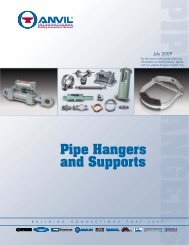Nibco Plastics Catalog - Paramount Supply
Nibco Plastics Catalog - Paramount Supply
Nibco Plastics Catalog - Paramount Supply
Create successful ePaper yourself
Turn your PDF publications into a flip-book with our unique Google optimized e-Paper software.
AHEAD OF THE FLOW ®<br />
Flanged Joints<br />
Scope<br />
Flanging is used extensively for plastic process lines that<br />
require periodic dismantling. Plastic flanges and factory<br />
flanged valves and fittings in PVC, CPVC, PVDF and polypropylene<br />
are available in a full range of sizes and types for joining<br />
to pipe by solvent welding, threading, or thermosealing as in<br />
the case with polypropylene and PVDF. Gasket seals between<br />
the flange faces should be an elastomeric full flat-faced gasket<br />
with a hardness of 50 to 70 durometer A. NIBCO can provide<br />
polychloroprene (CR) gaskets nominal sizes 1/2 through 8 having<br />
a 1/8 inch thickness. For chemical environments too aggressive for<br />
polychloroprene other more resistant elastomers should be used.<br />
Dimensions<br />
Bolt circle and number of bolt holes for the flanges are the<br />
same as Class 150 metal flanges per ANSI B16.5. Threads are<br />
tapered iron pipe size threads per ANSI B1.20.1. The socket<br />
dimensions conform to ASTM D 2467, which describes nominal<br />
sizes 1/2 thru 8. Internal NIBCO specifications have been<br />
established for the size 10 and 12 PVC patterns.<br />
Pressure Rating<br />
As with all other thermoplastic piping components, the maximum<br />
non-shock operating pressure is a function of temperature.<br />
Maximum pressure rating for NIBCO valves, unions and<br />
flanges is 150 psi. Above 100°F refer to the chart.<br />
Maximum Operating Pressure (psi)<br />
Operating Temp. °F PVC<br />
100 150<br />
110 135<br />
120 110<br />
130 75<br />
140 50<br />
150 N/R<br />
160 N/R<br />
170 N/R<br />
180 N/R<br />
190 N/R<br />
200 N/R<br />
250 N/R<br />
280 N/R<br />
N/R Not Recommended<br />
NIBCO INC. WORLD HEADQUARTERS 1516 MIDDLEBURY ST. ELKHART, IN 46516-4740 USA PH: 1.800.234.0227<br />
TECH SERVICES PH: 1.888.446.4226 FAX: 1.888.336.4226 INTERNATIONAL OFFICE PH: +1.574.295.3327 FAX: +1.574.295.3455<br />
www.nibco.com<br />
www.nibco.com<br />
Revised 9/10/2009<br />
ANSI B16.5 Dimensional Data for Flanges and Flanged<br />
Fittings<br />
(Dimensions and Bolts Conform to Class 150 Steel Flanges)<br />
Sealing<br />
Dimensions<br />
Nominal Outside<br />
Drilling<br />
Diameter Diameter of<br />
Size Diameter Number of Bolt Bolt Circle<br />
(inches) of Holes (Inches) (inches)<br />
1/2 3.50 4 1/2 2.38<br />
3/4 3.88 4 1/2 2.75<br />
1 4.25 4 1/2 3.12<br />
11/4 4.62 4 1/2 3.50<br />
11/2 5.00 4 1/2 3.88<br />
2 6.00 4 5/8 4.75<br />
21/2 7.00 4 5/8 5.50<br />
3 7.50 4 5/8 6.00<br />
4 9.00 8 5/8 7.50<br />
6 11.00 8 3/4 9.50<br />
8 13.50 8 3/4 11.75<br />
10 16.00 12 7/8 14.25<br />
12 19.00 12 7/8 17.00<br />
The faces of the flanges are tapered back away from the orifice<br />
area at a 1/2 to 1º pitch, so that when the bolts are tightened,<br />
the faces will be pulled together generating a force in the<br />
water way area to improve the sealing.<br />
INSTALLATION TIPS<br />
Once a flange is joined to the pipe, the method for joining two<br />
flanges together is as follows:<br />
1. Make sure that all the bolt holes of the mating flanges<br />
match up. It is not necessary to twist the flange and<br />
pipe to achieve this.<br />
2. Insert all bolts.<br />
3. Make sure that the faces of the mating flanges are not<br />
separated by excessive distance prior to bolting down<br />
the flanges.<br />
4. The bolts on the plastic flanges should be tightened by<br />
pulling down the nuts diametrically opposite each other<br />
using a torque wrench. Complete tightening should be<br />
accomplished in stages and the final torque values<br />
shown in the table should be followed for the various<br />
sizes of flanges. Uniform stress across the flange will<br />
eliminate leaky gaskets.<br />
87



